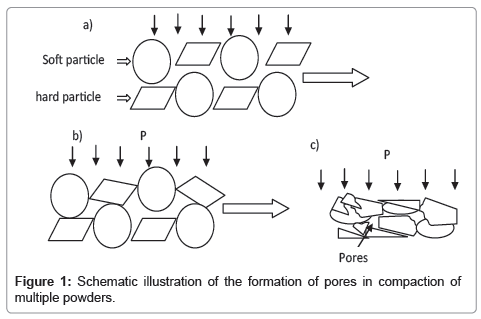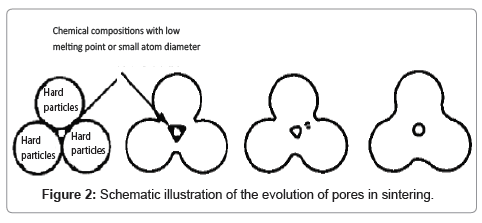Editorial Open Access
Pore Size Controlling in PM Alloy Parts
Yuanzhi Zhu1* and Yingying Guo2
1School of materials and metallurgy, Wuhan University of Science & technology, China
2Key Laboratory for Ferrous Metallurgy and Resources Utilization of Ministry of Education, Wuhan University of Science and Technology, China
- *Corresponding Author:
- Yuanzhi Zhu
School of materials and metallurgy
Wuhan University of Science & technology, Wuhan 430081, China
E-mail: tozyz1@163.com
Received Date: August 16, 2012; Accepted Date: August 17, 2012; Published Date: August 21, 2012
Citation: Zhu Y, Guo Y (2012) Pore Size Controlling in PM Alloy Parts. J Powder Metall Min 1:e103. doi: 10.4172/2168-9806.1000e103
Copyright: © 2012 Zhu Y, et al. This is an open-access article distributed under the terms of the Creative Commons Attribution License, which permits unrestricted use, distribution, and reproduction in any medium, provided the original author and source are credited.
Visit for more related articles at Journal of Powder Metallurgy & Mining
Abstract
Pores are important characteristics in powder metallurgy alloy parts. The effect of processing parameters on pore size is discussed. If pore size can be controlled as small as several or tens of nanometers in PM alloy parts, the parts may gain special physical or mechanical properties. The challenge to obtain pores sizing in several or tens of nanometers in PM alloy parts is discussed.
Pores are formed in compaction process of green compacts, and then coalesce or shrink in sintering. Pores are main characteristics of PM (powder metallurgy) alloy parts. These parts gain certain kind of properties due to the presence of pores inside. Thus, materialists are trying to control the shape, the size and the distribution of pores in the PM parts [1-2].
Pore Size in Green Compacts
Green compacts are usually compacted from multiple powders, which include both hard particles to construct the skeleton and soft particles to bind the skeleton. In the cold compaction of the multiple powders mixture, the pore size in the green compacts is mainly affected by the size and the shape of the hard particles in these powder mixtures. The specific process to construct the pores in the compaction process of the green compacts can be illustrated schematically, as shown Figure 1.
Here, hard particles are partially broken and rearranged to construct the shapes of pores in the green compacts. Soft particles are deformed and flow plastically, which act like a bridge to connect the adjacent hard particles. The size of pores is affected by the both of the size of hard particles and the compaction pressure in the cold densification process. However, the effects of compaction pressure on pore size in cold densification are very limited when the pressure reaches a threshold value [3]. Pore size in green compacts can be lowered by lowering the size of the hard particles in the multiple powder mixture [3].
Pore Size Evolution in Sintering of Green Compacts
Pores formed in cold compaction process would further evolve in sintering. Pores are Spheroidized and shrink by the diffusion of the atoms in the powders in sintering. Pore size in this stage is decided by the diffusion of chemical compositions with a lower melting point or elements with smaller atom diameter in the green compacts because they are easy to diffuse to the edges of these pores and partially fill the pores, which is illustrated in Figure 2 [4].
The pore size formed in sintering largely depends on the pore size in the green compacts and the holding time of them at a sintering temperature.
It may be of great interest to gain some special physical or mechanical properties of porous metals if the pore size in them can be controlled to as small as several or tens of nanometers [5,6].
Challenges in pore size controlling in P M alloy parts
It may be easy to control pore size to tens of nanometers on surfaces of metal membrane by lithography or etching techniques [5-7]. But the whole size of the porous parts fabricated by these techniques is very small. Pore size in inorganic materials, for instance in alumina can also be controlled as small as tens of nanometers by removal of water from between the crystal planes [8]. However, it is not easy to control the pore size in PM metals as small as several or tens of nanometers by traditional powder metallurgy process.
In traditional PM process, the particle size of the powder is usually a few or tens of microns, which construct the shape of pores.
Even if there are many methods available to make particles as small as tens of nanometers, for instance, attrition milling. However, if the particle size is too small, for example, as small as several nanometers, they aggregate easily in sintering. Thus, the sinterability of the green compacts would be deteriorated, resulting in crack-like voids in the sintered parts. Moreover, some metals are highly oxidizable, such as Al, Cu. The smaller the powder particle size is, the more susceptibility the particle tends to be oxidized even at an ambient with very low oxygen partial pressure. A tenacious surface oxide film may form, which would hindered the further sintering process [9].
These kinds of difficulties must be overcome if the pore size in traditional PM alloy parts can be controlled to as small as tens of nanometers.
Acknowledgements
This work is supported by the Department of international cooperation projects No.2010DFA52130.
References
- Barbosa AP, Bobrovnitchii GS, Skury ALD, Guimarães RS, Filgueira M (2010) Structure, microstructure and mechanical properties of PMFe–Cu–Co alloys. Materials & Design 31: 522-526.
- Youseffi M, Showaiter N, Martyn MT (2006) Sintering and mechanical properties of prealloyed 6061 Al powder with and without common lubricants and sintering aids. Powder Metallurgy 49: 86-95.
- Zhu YZ, Yin ZM, Xiang ZD, Zhe Z (2008) Cold densification behaviour of multiple alloy powder containing Fe–Cr and Fe–Mo hard particles. Powder Metallurgy 51: 143-149.
- ZHU Yuan-zhi, YIN Zhi-min, LI Xue-qian (2006) Hot densification of a sintered Fe-based alloy. Journal Central South University: Science and Technology 37: 455-460.
- Qian LH, Yan XQ, Fujita T, Inoue A, and Chen MW (2007) Surface enhanced Raman scattering of nanoporous gold: Smaller pore sizes stronger enhancements. Applied Physics Letters 90: 153120-153123.
- Biener J, Hodge AM, Hayes JR, Volkert CA, Zepeda-Ruiz LA, et al. (2006) Size Effects on the Mechanical Behavior of Nanoporous Au. Nano Lett 6: 10 2379-2382.
- Costas Pelekania, Vernon LS (2000) Competitive adsorption between atrazine and methylene blue on activated carbon: the importance of pore size distribution. Carbon 38: 1423-1436.
- Chakarvarti SK (2009) Track-etch membranes enabled nano-/microtechnology: A review. Radiation Measurements 44: 1085-1092.
- Fuentes JJ, Rodriguez JA and Herrera EJ (2011) Simplified PM processing of mechanically alloyed aluminnium. Powder Metallurgy 54: 160-166.
Relevant Topics
- Additive Manufacturing
- Coal Mining
- Colloid Chemistry
- Composite Materials Fabrication
- Compressive Strength
- Extractive Metallurgy
- Fracture Toughness
- Geological Materials
- Hydrometallurgy
- Industrial Engineering
- Materials Chemistry
- Materials Processing and Manufacturing
- Metal Casting Technology
- Metallic Materials
- Metallurgical Engineering
- Metallurgy
- Mineral Processing
- Nanomaterial
- Resource Extraction
- Rock Mechanics
- Surface Mining
Recommended Journals
Article Tools
Article Usage
- Total views: 7934
- [From(publication date):
November-2012 - Aug 23, 2025] - Breakdown by view type
- HTML page views : 3254
- PDF downloads : 4680


